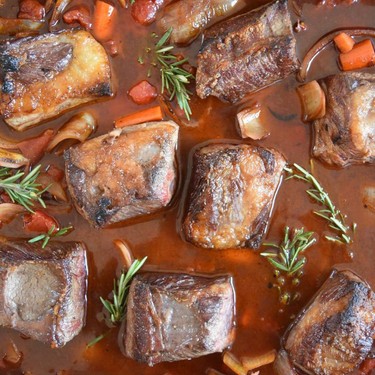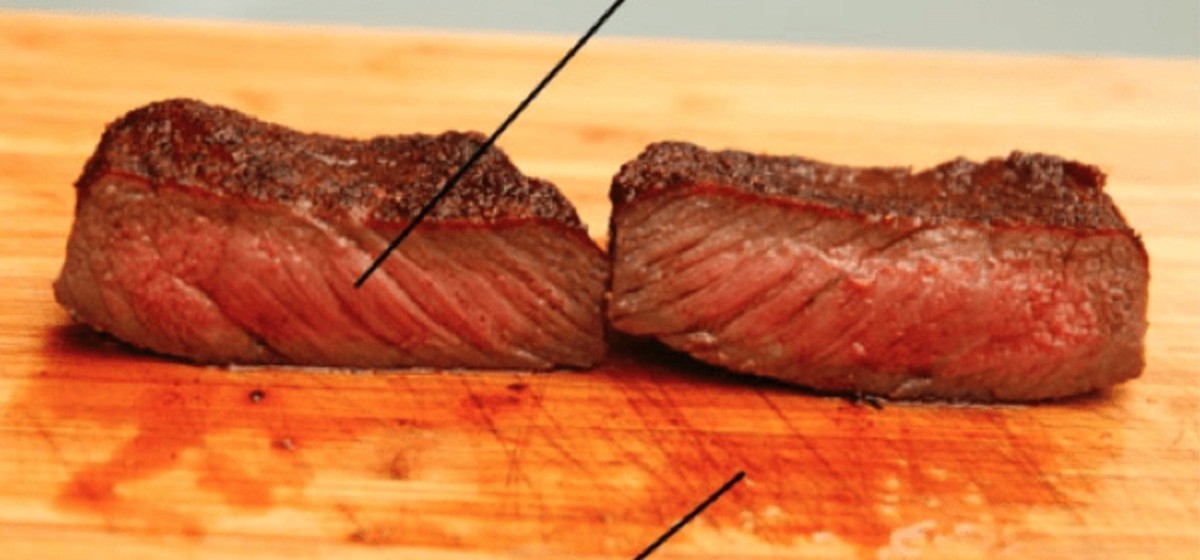To Braise or Not to Braise: 4 Tips for Cooking Meat Perfectly




You know that crust you love on the outside of your steak? Or that crunchy end of your pork roast? This is what happens when you cook your meat on the outside first. That deep brown sear is where you’ll get a lot of your flavor, caramelizing the outside and keeping your meat juicy and tender on the inside.
First, you want to take your meat out of the fridge and bring it to room temperature. Then, using a paper towel, pat it dry to get all the moisture off. Next, coat your sauté pan with oil or butter and get it extra hot. The fat should simmer, but not smoke!
Put your meat in the pan and take a step back. Hot oil+ wet meat = spatter!
Don’t overcrowd your pan. This will cause your meat to steam and not sear.
Pro Tip: You can also do this on a grill. Sear your meat directly on the flame and, once it’s got the crust you want, move it over to a cooler part of the grill to finish cooking.
Two thick inches of cast iron-seared, butter-basted, prime, beefy goodness...So much for meatless Monday.
Pan-Seared Filet Mignon Bordelaise is perfect for entertaining! Make the sauce ahead of time and sear the steaks at the last minute.
For larger and tougher pieces of meat, low heat for a long time is the way to go. Throw your poultry in a slow cooker surrounded by some great sauce and the meat will fall apart. Or get a big hunk of pork butt and braise it in the oven for a while. 6 hours later, you’ll have perfectly juicy swine for those pulled pork sliders you're making for the Super Bowl.
Now you know some different methods of cooking your meat, but how do you figure out which one to use? This depends on the cut of meat, so it's important to know your cuts.
These are pieces of meat that come from a part of the animal that is used a lot, like the shoulder or the rump. These pieces tend to have less fat and more muscle and connective tissue, so their texture will be chewy and sinewy. You want to break it down as much as you can, and the way to do that is the low and slow. You can braise, stew, roast, or BBQ. It’s the best way to make that tough piece of meat nice and tender. All these pieces are best served well done.
These pieces have more fat and less connective tissue and are on areas of the animal that aren’t used as much--think the loin or filet. These are best when cooked by searing the meat and then roasting, grilling, or even just popping in a sauté pan. You want to cook these to a specific temperature, because the longer you cook these cuts, the drier they will be. No one wants an overdone, chewy piece of steak.
The most important step to cooking a piece of meat is to let it rest. The meat will continue cook once you have pulled it out of the oven, so make sure you take it out a little before it’s reached your desired temperature.

AND LET IT REST.
We can’t stress this enough. You have to let it sit for at least five minutes before you slice into it.
As the meat rests and begins to cool, all the juices will get sucked back into the meat. And that’s what you want--a tender, juicy piece of meat. So, we know it’s tempting to cut right into that sucker, but trust me, it’s much better if you wait.
Rare: 115–120 degrees F (120–125 after resting)
Medium Rare: 120-125 degrees F (125-130 after resting)
Medium: 130–135 degrees F (135–140 after resting)
Medium-Well: 140–145 degrees F (145–150 after resting)
Well: 150–155 degrees F (155–160 after resting)
Medium: 140–145 degrees F (150 after resting)
Well-Done: 150–155 degrees F (160 after resting)
White Meat: 160 degrees F
Dark Meat: 175 degrees F